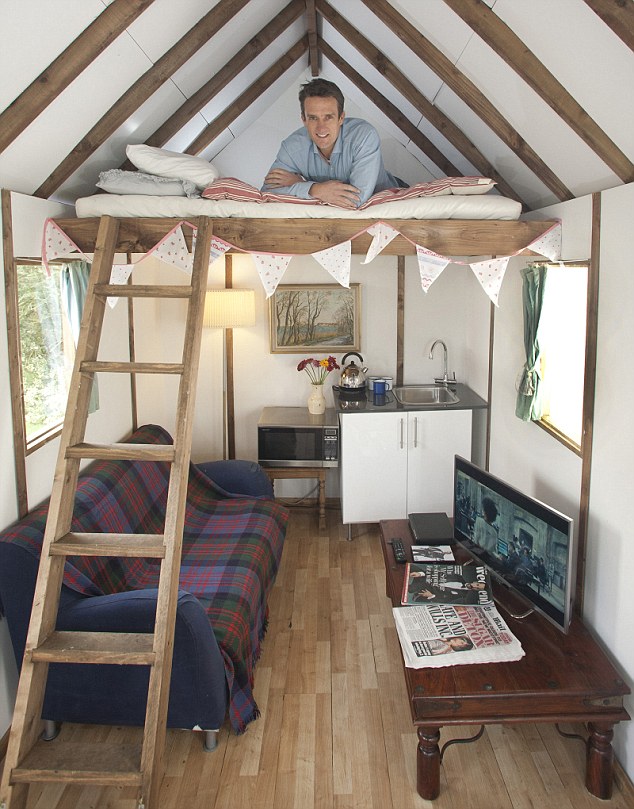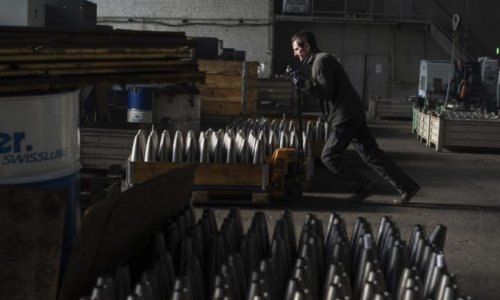While my chest puffs with machismo, my head is filled with doubts about my abilities.So when I heard that a British company has begun selling a flat-pack mini-house, which is said to be as easy to assemble as an Ikea bookcase, I couldn’t resist the challenge.At £6,500, they don’t come cheap, but the company which produces the wooden cabins — tinyhouseuk.co.uk — says that homeowners have been snapping them up. Mark Burton, the company’s founder, says the traditional wooden buildings are being bought by people desperate to acquire more space without moving house. Indeed, it seems there’s a growing market for ingenious ways to expand your home — without inflicting fatal damage on your wallet.Many of these involve creating separate, fully furnished buildings that include everything from sinks to beds, and are big enough to provide accommodation for a teenager or two, but small enough to fit in a garden without the need for planning permission. Late last year, a British engineer unveiled the QB2, a £10,000 mini-house that boasts living space for two. Then there’s the Hivehaus, a series of hexagonal modules that can be slotted together depending on how much living space is required.With three daughters aged four, eight and 11, space in my family’s Kent home is certainly at a premium. As we live in a traditional farm cottage, I eschew the modern mini-houses, and plump for a classic wooden design — setting myself the challenge of whipping up a mini-home in just seven days.SUNDAYAs the footballer Roy Keane famously once said: ‘Fail to prepare, prepare to fail.’ He may have been talking about qualifying for the World Cup, but I like to think the no-nonsense Irishman would adopt a similar attitude if he had just been asked to prepare a 15ft x 8ft base for his new house.For me, this involves levelling part of our front garden by digging up the turf and then hiding the huge pile of earth behind a shrubbery in the hope that my wife, Charlotte, can’t see the damage I’ve caused.I’m rumbled almost immediately and decide that now is probably not the ideal time to discuss my thinking about what we should do with any ‘waste water’ from the sink which will be fitted in the finished cabin. MONDAYMy excitement at the arrival of my tiny house is tempered by the fact that this morning the perfectly flat base of my house — plywood screwed down on to a rectangle of timber, which I laid yesterday after moving the turf — now has clearly discernible undulations.It may have something to do with the fact it rained non-stop all night. This means I can’t do any more work on it today. Shortly after midday, the main structure for the house arrives in the back of a lorry and I unload 16, 6ft-tall wall panels and about 200 individual pieces of wood. Bedtime reading is seven sides of hand-written instructions, courtesy of Mark Burton.He’s also thrown in a hand-made scale model showing what the finished cabin (don’t call it a shed!) should look like.Confidence builds and I start imagining my daughters having sleepovers in it, proudly boasting to their friends that their dad built it.TuesdayThe good news is that it’s stopped raining, so building work can theoretically begin again. The bad news is that the water on the base has now frozen, creating an ice-rink — much to the delight of my daughters. Once they are packed off to school, I don thick gloves — not to mention my coat and scarf — and start trying to lug the wooden panels which make up the house walls into a vertical position. The wooden framework has an MDF board pre-fixed on what will be the inside wall. This means that once the panels are in position, the interior will be ready to paint. Each panel is numbered, allowing me to butt the appropriate ones next to each other and then screw them down — first into the base and then into one another. By lunchtime, I have completed the rectangle of walls without any major difficulty. Structurally, my little house is already remarkably strong given that it is held together only by a handful of screws. The next step is to add the pointy gables onto either end of the house and to connect them by the ridge beam — a long strip of wood which runs the length of the roof. Because the ridge stands less than four metres tall, most local authorities would not require such a structure to have planning permission.This is just as well, as I’ve already noticed the neighbours peering nervously through the hedge at this new addition to my garden...WednesdayPerhaps yesterday wasn’t as easy as I’d thought — every muscle in my body aches when I wake up this morning. But there’s no time for a lie-in. With the ridge in place, it’s time to tackle the roof. This involves balancing on top of my wobbly old stepladder while I try to fix the rafters into place — thin wooden beams which connect the top of the walls to the ridge in the middle of the roof.What feels like hundreds of metal screws later, and I’m done.Then it’s a case of laying a waterproof membrane — which looks suspiciously like a bit of old plastic sheeting — over the top. I then fix overlapping lengths of wooden cladding on top of the sheeting to create the finished roof.By this point it’s mid-afternoon and I’m exhausted, but I really need to get the outside layer of wood — called cladding — onto the basic walls I put up yesterday. If it rains overnight, my inner walls will get wet and this will delay the rest of my building work.I step up the pace and use all the same techniques on the walls that I did on the roof, affixing beams, the planks of wood. When I run into difficulties working out which boards go where, I call Mark for advice and — glad of the break from manual labour — we get chatting about the people who are buying the cabins. He tells me it is those who can’t afford to get on the housing ladder, students who don’t want to waste money on rent, parents wanting extra space for teenagers and older people who have come to the realisation that there are better things to spend their money on than maintaining a large house.But he adds that the problem many potential clients face is finding somewhere to put their tiny house. After all you can’t just plonk it down in the middle of a roundabout or on the local village green. And if you have to buy a suitable bit of land, then the cost is self-defeating. ‘I’d like to see some land set aside to set up a village of tiny homes,’ says Mark. ‘You often have elderly people living together in mobile homes — why not have younger people doing the same, but in these sort of things?’Looking at my half-finished mini-house, I’m not sure there would be many takers.ThursdayDespite my aching arms, countless splinters and chapped hands, I wake up feeling strangely energised. My mini-house might not be particularly sophisticated, but I have built something with walls and a roof, in which my family could conceivably shelter in a disaster, and feel quite chuffed with myself. I start fixing the glass in the windows. In my version I am just using basic panes of glass, but if I were to live in it full-time then proper, double-glazed windows would be a must. I also fit the glass in my front door and hang it from its hinges. It doesn’t shut particularly well — but then again, nor do any of the doors in my real house, all of which have swollen in the rain and are currently driving me mad. Down one end of the building I also fix the internal joists for what an estate agent might describe as a mezzanine floor. FridayI am totally shattered and never want to see a screwdriver again, but feel so close to the finishing line I’ve no choice to continue with my project. I’m also on a bit of a high at what I’ve accomplished, I can’t believe how satisfying this work is (when it goes well).The inside of my new house looks bare, so I give the MDF on the internal walls a couple of coats of paint and fix some insulation in between the rafters — vital if anyone who sleeps in it isn’t to get hypothermia. I also tackle the floor, fitting some laminate floorboards which I picked up at a local hardware store. At this point the sage words of Mr Keane came back to bite me. My poor preparation of the base has resulted in a distinctly lumpy floor, which means the boards won’t clip into one another as easily as the instructions promise. Like all the best craftsmen, I solve the problem by banging some nails through the boards that keep popping up. They may not be totally smooth, but the pale pine looks chic enough to pass muster with my wife, Charlotte.I then set about the furnishings. The bed area is easily big enough for a double mattress, below which I position a sink unit. Many of the people Mark supplies his buildings to are keen to live entirely ‘off-grid’ — in other words to be self-sufficient and take nothing from the utility companies. To do this I would need to install a solar system on the roof to provide electricity and then add water tanks and the like. I don’t have the time — or inclination — to do this, so I just run a cable from my house which I use to power my TV and DVD, a couple of lights, a fan heater and a microwave. Hurrah! The house that Tom built is finished, and it looks pretty darn good. My chest is now perpetually puffed out with manly pride. I invite Charlotte and the girls in for a look around, and can’t help but feel chuffed as they coo over how ‘cute’ it is. But there’s definitely not room for the whole family to sleep here so, despite the girls’ protests, I evict them and settle down for an evening of quiet time. I heat up a chilli con carne in the microwave, pop a Bond film on the box and then head to bed. Outside the wind may be whistling and the rain falling, but my little house is watertight — and surprisingly snug.SaturdayWhen I wake, I’m struck by two things. First, because the house is so small it doesn’t take long to warm up when I turn on the heater. Second, while undoubtedly compact, the cabin holds a surprisingly large amount of my stuff. I could definitely imagine a single person or a couple living comfortably within it. Is it better than a mobile home or a large caravan? The height of the roof means that it doesn’t feel at all cramped and it certainly looks and feels more permanent and homely. If it’s to be a permanent home, rather than just temporary accommodation, then the ‘look’ and ‘feel’ of a property is essential — you have to feel affection towards your house. Building it yourself and customising it definitely fosters those emotions. Or it certainly did in me — I wonder whether Charlotte would mind if I spent just one more night in it... .(dailymail.co.uk)ANN.Az
Could YOU build a flatpack house? - PHOTO
World
16:15 | 30.01.2014

Could YOU build a flatpack house? - PHOTO
Like most British men, the sight of a screwdriver and something to assemble from a flatpack sends me into a competitive tailspin.
Follow us !










